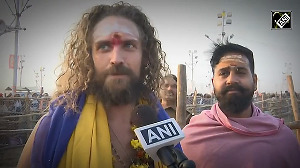Some wanted accelerated efforts to land men on Mars to worship the godlike beings, who obviously possessed such advanced technology and evolved aesthetics. Others demanded that the red planet be declared consecrated ground and all exploration halted forthwith.
On Earth itself, there is the Giants Causeway in Ireland; some 40,000 columns stepping into the sea, a short walk from the Bushmills distillery.
It is not necessary to have liberally sampled one of the world's great whiskeys or listened to Houses of the Holy to imagine this was built by a giant who wanted to stroll across to Scotland.
That's the explanation in Celtic legend, though geologists have been heard to suggest that it was actually formed through natural volcanic action.
Men of faith live by the strong anthropomorphic principle; if there's a pattern, it must be by design. It is impossible to prove that there are no gods on Mars because the apparent absence of deities could be due to unwillingness on their part to be found.
Rock formations often create strange patterns through natural geological actions. But this is no proof that a given formation is not artificial.
Another causeway is slap-bang in the middle of controversy at the moment. It's variously called Rama's Bridge or Adam's Bridge. This shallow area makes it impossible for ships of normal draught to sail directly from India's West Coast to the East Coast. They must go around Sri Lanka instead.
If a 167-km channel of 12-metre draught is dredged through this "Bridge", it would reduce distances between ports on India's two coasts by distances of up to 750 km. The first proposal to dredge such a channel was made in 1860 and it was seriously mooted again in 1955.
A Rs 2,500-crore (Rs 25 billion) plan was adopted in 2005. There were protests from environmentalists. Economists said the cost-benefit analysis was optimistic since draught limitations allow only about 25 per cent of traffic to navigate the short-cut.
It was opposed by Sri Lanka - Colombo port stands to lose traffic if this channel is cleared. Despite these rational arguments against it (one must consider the cost of poor diplomatic relations with a prickly neighbour), work proceeded.
The channel is now about 30 per cent complete. Then the religious right got into the act. Why did the Rambhaktas wait until massive resources had been committed and why are their posturings given more credence than rational arguments? There is no politically correct answer. The multitude of non-PC answers all revolve around votes.
Whatever you believe, the opposition to the Sethusamudram Canal was initiated by a Buddhist nation, by green activists and by economic rationalists. I find it most ironic that this opposition has now been successfully hijacked by people who have nothing in common with any of the above.
Reliance Retail to shelve UP, Orissa plans
In this case, the cost-benefit is unclear. But can one find rational justifications for back-pedalling on organised retail in UP and Orissa? In their desire to protect small traders, the UP and Orissa governments will "uncreate" over 10,000 new jobs. The aam aadmi, who would have benefited from lower prices and greater choice, will continue to bargain with the local lalajis, who enjoy the fattest margins in the world.
It's difficult to justify this in terms of votes. The families with lost jobs and the aam aadmi who pay higher prices clearly collectively outnumber the interest group that benefits from the rollback. It's absolutely impossible to justify it in economic terms.
However, as the Sethusamudram imbroglio indicates, rational argument doesn't get you anywhere. If you want to get your way, you must somehow drag religion into the debate.
In order to trigger a rethink in policy, somebody, somewhere, must unearth a mandate for retail chains from somewhere within the dogma of mainstream religion.







 © 2025
© 2025